Article Archive
Corona and Tracking Conditions in Metal-clad Switchgear Case Studies
James Brady
Level-III Certified Thermographer
Brady Infrared Inspections, Inc.
935 Pine Castle Court
Stuart, FL 34996
772-288-9884
Abstract
It has been known for some time that ultrasound and infrared technologies complement each other when conducting inspections of switchgear over 1000 volts. At this voltage and higher, the electrical potential field is such that corona and tracking conditions can occur. Yet, very little information has been published describing techniques for performing thermal, ultrasonic and visual inspections to detect these enigmatic problems.
This presentation will attempt to take the mystery out of the occurrence of corona and tracking in metal-clad switchgear and present case studies that have been documented over the past three years. Thermograms and ultrasound audio files will be integrated into this presentation to show their relationship to problems that occur in this type of electrical equipment.
Introduction
Electrical discharge in the form of corona and tracking has caused many failures in metal-clad switchgear with little advanced warning or understanding of the cause. This is especially frustrating for the end-user when infrared technology is being utilized as a predictive tool to prevent such occurrences. Because corona and tracking conditions are voltage problems that rarely produce heat, they go undetected during a typical infrared inspection. Fortunately, the combined use of ultrasound and infrared can enhance a switchgear inspection program by providing early detection of both heating and non-heating problems.
Several years ago, I was introduced to ultrasound technology at an IR/INFO conference. After realizing the applications and benefits of this predictive maintenance tool, we were soon offering this service as a routine part of our infrared inspection business. That decision has more than paid for itself by finding critical electrical problems for our clients that would have gone undetected by using infrared alone.
What are Corona and Tracking?
Corona refers to the faint glow surrounding an electrical conductor of 3500 volts or greater as a result of the ionization of air as the nitrogen in the air breaks down. When corona occurs, it creates ozone (detrimental to the human lungs, eyes, etc.), ultraviolet light, nitric acid, electromagnetic emissions and sound.
Ozone is a strong, odorous gas that deteriorates rubber-based insulation. If moisture or high humidity conditions exist, nitric acids can also be formed that attack copper and other metals. The electromagnetic emission can be heard as interference on AM radios and the corona sound can be heard by the human ear and ultrasonic scanning devices.
One important point to consider is that unlike infrared that detects heating due to current flow, corona indicates voltage problems and can be present without current flow. High potential in the electrical field is the major dictating factor for its presence. Corona activity is at its strongest on the positive (+) and negative (-) peaks of the 60Hz cycle.
Once corona becomes active, it leaves behind a conductive “tracking” path on surfaces and also creates a very conductive cloud of air around itself. A flash-over can occur once a tracking pathway is completed from phase to phase or phase to ground (Fig. 1). It can also occur from the conductive cloud of surrounding air once it finds a path to ground.
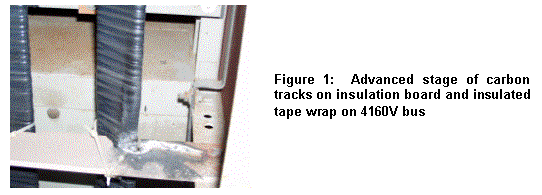
What Causes Corona?
Based upon numerous observed conditions of corona, there are three primary causes for its development: geometric factors, spatial factors, and contamination.
Geometric factors include sharp edges on conductors, connections and switchgear cabinet components. This may be the result of sharp or squared tape wraps in conductor terminations, tag ends on conductors, and corners and points on cabinet bracing and support shelves.
Spatial factors include small air spaces between conductors, insulation board, and switchgear cabinet components. This may result from: 1) conductors being tie-wrapped together; 2) conductors touching insulators, conduit, and edges of cabinets; 3) non-shielded cables in contact with grounded surfaces; 4) bus bars in close proximity to fiber-resin supports and insulator material (Figure 2).
Finally, contamination in the forms of dust, oils/fluids, and other particulates on conductors and insulators will create corona (Figure 3). Corona conditions are exasperated by humid and wet conditions.
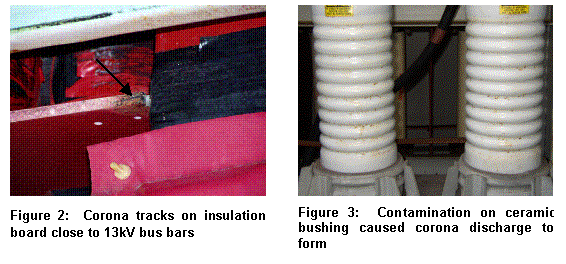
Visible Signs of Corona and Tracking
Probably the most noticeable sign of corona will be the smell of ozone, since this is the major by-product of corona.
Early stages of corona may not show any visible signs. Mild cases of corona that are caused by metal edges in switchgear cabinets may never be detected by visual inspection alone.
Typically, the effects of corona on rubber-based insulators, tape, and insulation board will leave a white, fibrous power residue or dust (Figure 4). This dust is the physical breakdown of the material.
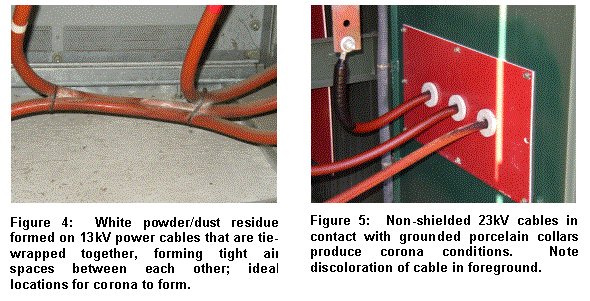
As the condition worsens, carbon tracks develop on conductors and insulators. The distance between the phase and ground will determine the time to a flash-over.
Others indicators include discoloration and pitting on cable insulation (Figure 5). Usually, dull finishes and micro-crack stains on cable insulation will be noticed. In worst case scenarios, cables will be severely deteriorated (Figure 6).
Unusual weathering patterns on copper bus and conductors are also good indicators of corona (Figure 7). Humid and wet conditions inside switchgear cabinets will allow nitric acid to form which attacks the copper surface, leaving unusual weathering patterns. Cabinets lacking heaters, cabinets with poor weather seals, and those next to wet industrial processes are especially vulnerable to these conditions.
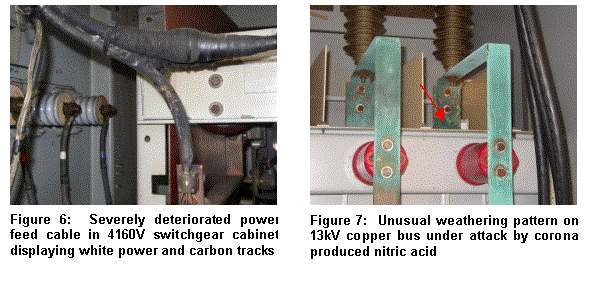
Corona and Heating
Corona activity can produce a very faint heating pattern due to the molecular disturbance of electrons associated with the ionization of air (personal communication with Dan Ninedorf of Ox Creek Energy Associates Inc.). Depending upon air movement and the intensity of the corona, the delta temperature may or may not be detectable with infrared technology (Figures 8a & 8b). This can be deceiving for the infrared thermographer who is unfamiliar with corona, as this serious condition may only receive a minor severity rating if evaluated on temperature rise criteria alone.
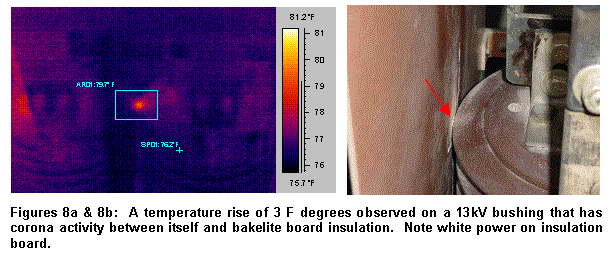
Arcing conditions that produce delta temperatures detectable by infrared technology can be associated with corona dust. The conductive nature of the white power left by corona can support arcing conditions (see Case Study 4).
Ultrasound Technology
Sounds above the normal range of human hearing (20 Hz to 20 kilo-Hertz (kHz)), are typically thought of as ultrasonic. A frequency range between 20 kHz to 40 kHz generally covers all of the ultrasonic applications used for predictive maintenance applications; leak detection, steam traps, bearings and lubrication, and electrical discharge.
The equipment includes a receiver unit, headphones, and various modular listening devices that attach to the receiver for both airborne and structure-borne scanning. Airborne devices include cone-shaped collectors that capture ultrasonic waves traveling through air. Structure-borne devices include magnetic base collectors and rod attachments used to contact the surface of equipment.
Through a process of “heterodyning”, the ultrasound signal is converted by the receiver unit to a low frequency audible signal that can be heard through the headphones. There is also a read-out display that shows the intensity of the received signal.
Using Ultrasound to Detect Corona and Tracking
Because corona and tracking problems are occurring in air, it makes sense that the best technique to detect these problems is through airborne ultrasound. Ultrasonic waves are very directional in their movement making it relatively easy to track problems back to their source. Because ultrasound waves are directional, they will rebound off surfaces and can be partially and completely blocked. Using common sense and following the unit’s strongest received signal will usually point the operator to the problem. The operator can also use blocking techniques to filter out competing ultrasound noises, if necessary.
Prior to opening a switchgear cabinet, it should be standard practice to scan ventilation screen openings, the seams around the doors, and the cabinet bolt holes once a few are removed. Typically, advanced cases of corona and tracking will be heard using this “initial” scan technique. However, the interior geometric design of the cabinet may not always allow the signal to reach the ultrasound collector or may only allow a partial and weak signal to be heard. Likewise, mild cases of corona may have a very weak discharge signal that is not heard until the cabinet is open. If you have any question about the safety of opening a switchgear cabinet, do not open it until an outage can be secured.
Other problems that may affect the initial scan are competing ultrasonic noises generated by mechanical vibration from inside switchgear cabinets and hand tools used to open the cabinets. Mechanical vibration signals can sound a lot like electrical discharge signals. By applying light pressure on the sides of cabinets and doors, you can reduce or eliminate a mechanical signal and rule it out as electrical discharge.
Opening switchgear cabinets is a risky business that should only be performed by qualified persons wearing the appropriate arc-flash protection equipment as prescribed by the NFPA 70E guidelines. If at all possible, cabinets should be open while de-energized, and then energized for the inspection. If a strong smell of ozone is detected, do not open the cabinet until it is de-energized. Drafting air into a cabinet with advanced corona and tracking conditions may move conductive air over a grounded object and cause a flash-over.
Teamwork between qualified persons is a must. If you are an “in-house” technician with high-voltage switchgear, consider installing hinges on doors and modifying bolts that can be easily handled while wearing gloves. Doors should be opened very slowly. You should minimize your exposure in front of the open equipment.
Once open, the inspector should slowly scan the interior of the cabinet making sure to cover the entire area. Both front and back compartments should be scanned, if accessible. The ultrasound instrument or any body parts should never break the plane of the cabinet or exceed the approach distance for the given voltage class.
What are We Listening For?
Corona problems will be heard as a continuous buzzing or frying noise. The intensity of this noise will be directly related to the severity of the problem. Tracking problems will sound much like corona problems, but will have pauses and possible drops and builds in intensity.
Once a problem is detected, the problem should be described, photographed, and recorded, if desired. Because of the dangers involved with getting too close to this type of equipment, using a telephoto lens will help become your eyes to get close to problems. Also, a bright flashlight will help illuminate dark and tight areas where corona problems may occur.
Corrective Action
You just received word that corona is present in your switchgear. How bad is it? What corrective action should I take?
The presence of corona and/or tracking in switchgear is a serious problem that should be addressed as soon as possible. The following corrective actions have been suggested by Mark Lautenschlager, PE and Senior Vice-President of Engineering with High Voltage Maintenance Corporation in an article printed by NETA World, Fall 1998.
-
Any physical sign of breakdown or injury to conductors, insulators and insulation board should be corrected by repairing or replacing the damaged component
-
Fill air gaps with silicon tape, silicon sealant or other corona suppressive compound. Air gaps can also be increased or replaced with porcelain insulators
-
Smooth sharp edges, apply corona rings, apply semi-conductive tape or compound, or wrap edges with metallic screening to form round conductive surfaces
-
Replace damaged terminations and splices on conductors. Support non-shielded cables from ground
Conclusion
Unlike resistance problems associated with current flow that can be detected by infrared, corona is a voltage problem that seldom generates heat. Corona and tracking problems can be easily missed by infrared and remain enigmatic until a major fault occurs that destroys switchgear equipment. The use of ultrasound technology compliments an infrared inspection program by increasing one’s ability to locate these destructive problems and take corrective action.
In most cases, corona and tracking problems provide visual evidence of their existence. Understanding the factors that cause these problems and their physical clues should bring a new awareness to the infrared thermographer.
Case Studies
Four case studies are presented here that provide a cross-section of various problems and conditions associated with corona and tracking in metal-clad switchgear.
Case 1: Tracking Inside 13kV Rack-in Breaker Cabinet
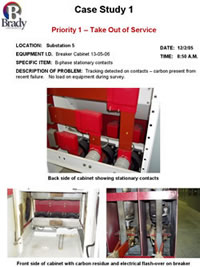
Background: During a recent inspection at a substation for a utilities provider, a series of 13kV rack-in
breaker cabinets were being scanned with infrared and ultrasound. One of the rack-in breakers was completely removed from the main bus cabinet following a recent flash-over. Because of the “no load” conditions inside the cabinet, infrared was ineffective; however, tracking discharge was easily picked up by the ultrasound scanner.
Comments: The most logical explanation for the tracking condition is that the problem that caused the initial flashover is still present. The presence of carbon-rich flash residue will only exasperate the situation by providing very conductive material for tracking paths.
Avoided Cost: Prevented the potential loss of a main bus responsible for five feeder breakers at a downtown substation.
Case 2: Tracking Inside 13kV Load Interrupter Switch
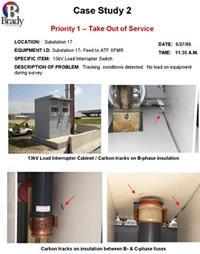
Background: During an inspection last year at a citrus industry facility, the outside ventilation screen on a 13kV load interrupter switch cabinet was scanned using ultrasound. The switch was tied to a step-down transformer which in turn was tied to 480V switchgear, of which the main breaker was open. Because of this, it was determined that the 13kV switch was under very light load.
Ultrasound detected a very strong signal characteristic of tracking conditions. The 13kV switch was de-energized and opened for visual inspection. Carbon tracks were discovered on the insulation board separating the B- and C-phase fuses.
Comments: Fortunately, this condition was found just in time. This switch was scheduled to be brought on-line with load shortly after the inspection and would have undoubtedly failed soon thereafter. Maintenance personnel replaced fuses, cleaned all metal parts and installed new insulation board. Once repairs were complete, the switch was energized and a follow-up ultrasound scan was performed, confirming repairs were successful. The switch was then brought on-line with load. Ultrasound and infrared were performed, again confirming that repairs were successful.
Avoided Cost: Prevented the potential catastrophic loss of a 13kV load interrupter switch responsible for over 20 million gallons of citrus product storage.
Case 3: Corona Inside 13kV Transformer Cable Compartment
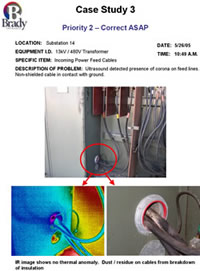
Background: During an inspection last year at a citrus industry facility, a pad-mounted, step-down transformer cabinet was scanned with infrared and ultrasound. Infrared results showed all connections and conductors to be normal. Ultrasound found advanced stages of corona on the 13kV power feed cables entering the transformer cabinet through a 3-inch galvanized conduit.
Comments: A visual sign of the corona was white residue power in the small air gap spaces between the cables and the conduit.
Avoided Cost: Prevented the potential catastrophic loss of a pad mounted transformer and adjacent 13kV load interrupter switch responsible for the plant’s feed mill operations. All of the others plant’s operations are dictated by the operation of the feed mill.
Case 4: Corona and Arcing on 23kV Ceramic Bushing
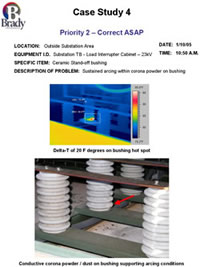
Background: During an inspection two years ago at a telecommunications provider for South America, the 23kV main switchgear cabinet for the facility was inspected with infrared and ultrasound. Infrared results showed a small hot spot on one of the ceramic support bushings for the B-phase bus. Ultrasound found advanced stages of corona at the same location.
Comments: A visual sign of the corona was white residue power at the same location as the hot spot. Communication with Dan Ninedorf of Ox Creek Energy Associates, Inc. about this unusual hot spot revealed that arcing conditions can be supported within the white power dust of corona.
Avoided Cost: Prevented the potential catastrophic loss of the main switchgear responsible for the facility’s operations.
Acknowledgements
The author would like to thank the following people instrumental in compiling this paper. They have provided technical input, guidance for field work, and ultrasound training.
James Hall – Ultra-sound Technologies
Atlanta, GA area
(770) 517-8747
www.ultra-soundtech.com
Dan Ninedorf – Ox Creek Energy Associates Inc.
Montello, WI
800-531-6232
www.corona-technology-course.com
Technical References
Lautenschlager, M., PE., 1998, Corona – Is There Anything Good About It?, NETA World, Fall 1998.
Advertisement


